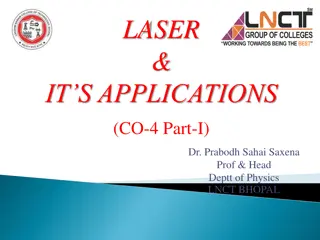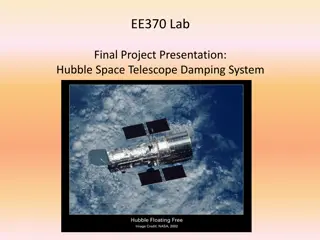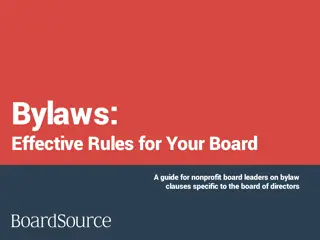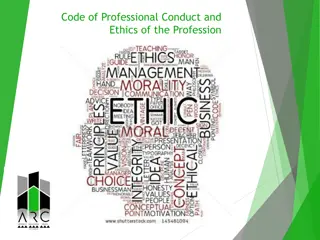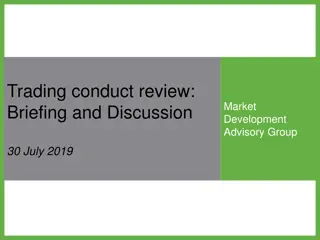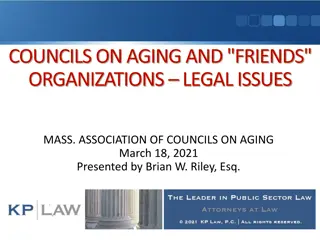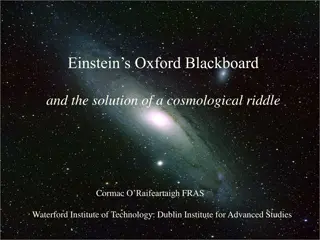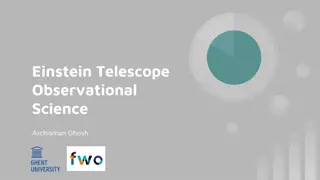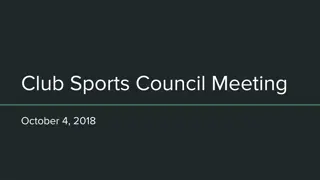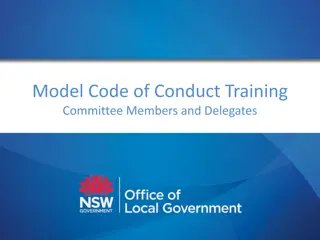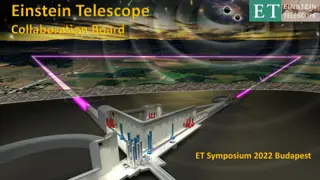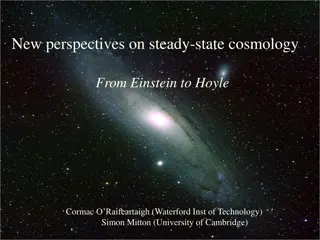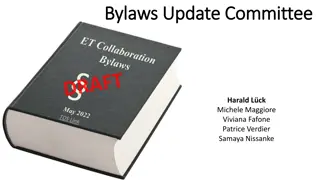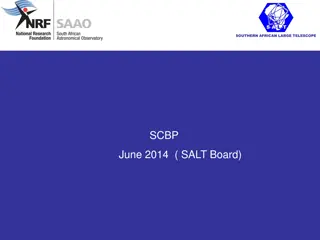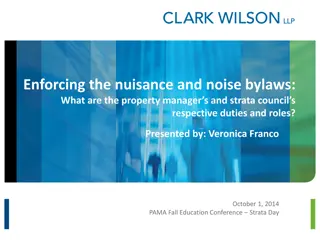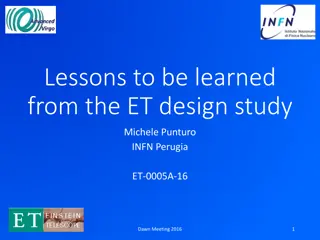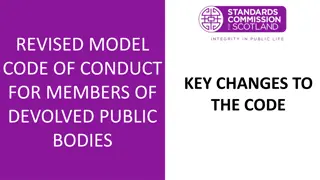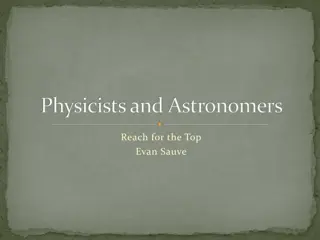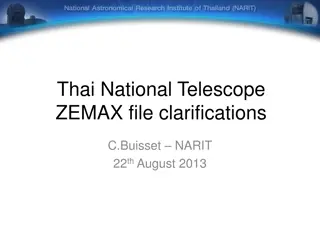Einstein Telescope Collaboration Bylaws and Code of Conduct
The Einstein Telescope Collaboration has established internal rules and a Code of Conduct to ensure a professional, respectful, and inclusive environment free from discrimination and harassment. All members are expected to adhere to these guidelines to foster a supportive atmosphere for scientific discourse. The Collaboration Bylaws emphasize the importance of working together towards the common goal of realizing and operating the Einstein Telescope.
Download Presentation

Please find below an Image/Link to download the presentation.
The content on the website is provided AS IS for your information and personal use only. It may not be sold, licensed, or shared on other websites without obtaining consent from the author.If you encounter any issues during the download, it is possible that the publisher has removed the file from their server.
You are allowed to download the files provided on this website for personal or commercial use, subject to the condition that they are used lawfully. All files are the property of their respective owners.
The content on the website is provided AS IS for your information and personal use only. It may not be sold, licensed, or shared on other websites without obtaining consent from the author.
E N D
Presentation Transcript
Einstein Telescope XII. ET Symposium 7th + 8th June 2022 Budapest Harald L ck Institute f r Gravitationsphysik of the Leibniz Universit t Hannover; Albert Einstein Institut Max-Planck Institut f r Gravitationsphysik
Proto-Council External Advisory Bodies Scientific and Technical Advisory Committee Program Advisory Board Finance Board Policy & monitoring BGR (Board Governm. Represent.) ESFRI Coordinators Stan Bentvelsen, Antonio Zoccoli BSR (Board Scient. Represent.) ET Collaboration Project Directorate Jo v.d. Brand, F. Ferroni CERN monitoring Policy proposals+ monitoring MOA CERN-INFN-Nikhef P. Chiggiato CB EB Deliverables: Beam pipe vacuum Site Preparation Civil Infrastructure Collaboration Board Executive Board monitoring reporting Informing delivering TDR ET Vacuum Pipe reporting managing managing SF SSB reporting managing Services and Standards Board Science Forum INFRA-DEV M. Martinez WP1 Coordination and Management WP2 Organization , Governance, Legal WP3 Financial Architecture WP4 Site Preparation WP5 Project Office/Engineering Dept. WP6Technical Design WP7Transfer of Technology WP8 Computing and Data Access WP9 Sustainable Development Strategy WP10 Education, Outreach, Citizen Engagement Requirements & competences Providing services supervisioning participating Engineering Department EIB SCB Site OSB ISB Electronics/ Computational Infrastructure Board Providing services Observational Science Board Instrument Science Board Characterisation Board Setting up Project Office Specific Boards ET Project
Bylaws: for whom / why? The Bylaws only concern the Collaboration and its internal rules. As the name says: A Col-laboration is a group of people that are working (laborare) together (co-, cum) for a common goal: The realisation and operation of the Einstein Telescope Working together needs rules and a will to adhere to them. The Code of Conduct is hence an essentail chapter of the Collaboration Bylaws.
Bylaws: Code of Conduct The ET Collaboration strives for workplaces free from discrimination and harassment. It is the policy of the Collaborations that all members will conduct themselves in a professional manner that is welcoming to all participants and free from any form of discrimination, harassment, or retaliation. Members will treat each other with respect and consideration to create a collegial, inclusive, and professional environment. Creating a supportive environment to enable scientific discourse is the responsibility of all members. Members will avoid any inappropriate actions or statements based on individual characteristics such as age, race, ethnicity, sexual orientation, gender identity, gender expression, marital status, nationality, political affiliation, ability status, or educational background. Disruptive or harassing behaviour of any kind will not be tolerated. - Harassment includes but is not limited to inappropriate or intimidating behaviour and language, unwelcome jokes or comments, unwanted touching or attention, offensive images, unwelcome photography, and stalking. - Disruptive behaviour includes instances of disrespect and lack of civility in interactions with colleagues. All members are expected at all times to deal with and address their fellow colleagues with respect and courtesy. This includes, but is not limited to, behaviour in in-person meetings, virtual (remote) meetings, chats, social media, email communications and other communication formats. Any professional relationship or action that may result in a conflict of interest in the context of ET must be fully disclosed. When objectivity and effectiveness cannot be maintained, the activity should be avoided or discontinued. The ET Collaboration also will not tolerate instances of scientific misconduct, which is characterized by any of fabrication, falsification, or plagiarism in proposing or performing research in the ET Collaboration. Fabrication means making up data or results. Falsification means manipulating research materials, equipment, or processes, or changing or omitting data or results such that the research is not accurately represented in the research record. Knowingly reporting or reproducing fabricated or falsified results of others is also considered as misconduct. Plagiarism means the appropriation of another person's ideas, processes, results, or words without giving appropriate credit. Violations of this code of conduct policy should be reported as soon as possible to meeting organizers, working group chairs, or the ET Leadership - whatever is most appropriate in the situation. If desired/required, the Ombudsperson (see section G) can be called on and assist in finding an appropriate complaints procedure.
Code of Conduct - ctnd Any violations of the Code of Conduct will be pursued through discussion with the party or parties involved, if desired, with the help of a mediator chosen by the disputing parties. Significant violations can result in immediate consequences in access to ET Collaboration activities; repeated marginal violations also will be addressed. Sanctions for violations of this Code of Conduct will be determined following the grievance procedure, and may result, in serious cases, in the permanent exclusion of an individual or group from the ET Collaboration. Conflicts which cannot be resolved through collaboration procedures will be referred to the institution of the person(s) who may have violated the Code of Conduct. The Collaboration may take action based on the institution s findings. Retaliation for complaints of inappropriate conduct will not be tolerated. If a member observes inappropriate comments or actions and personal intervention seems appropriate and safe, they should be considerate of all parties before intervening. This Code of Conduct is the defining document for the ET Collaboration. A policy for formal complaints in case things do not work as expected is given in the appendix F.3.4.
Collaboration Organigram ET Collaboration Policy proposals+ monitoring CB EB Collaboration Board Executive Board Informing managing reporting managing SSB SF reporting managing Services and Standards Board Science Forum Providing services supervisioning participating Specific Boards EIB SCB Site OSB ISB Electronics/ Computational Infrastructure Board Observational Science Board Instrument Science Board Characterisation Board
OSB: Observational Science Board Marica Branchesi - Michele Maggiore - Ed Porter Synergies w. other GW observ. Stellar collapse and isolated neutron stars Fundamental physics Population Studies MM Nuclear physics Science Potential Cosmology Waveforms DA platform observations Marie-Anne Bizouard Enrico Cappellaro Pablo Cerda-Duran Chris v.d. Broeck Paolo Pani Raphael Porto Giancarlo Ghirlanda Stephen Smartt Susanna Vergani Nelson Christensen Samaya Nissanke B. Sathyaprakash Tim Dietrich Tanja Hinderer Michaela Oertel Laura Bernard Harald Pfeiffer Patricia Schmidt Michal Bejger Ik Siong Heng Andrea Maselli Chris v.d. Broeck Elena Cuoco Tania Regimbau Archisman Ghosh Angelo Ricciardone Mairi Sakellariadou Giulia Cusin Michela Mapelli Antonio Riotto Waveforms relevant for ET Improvementof waveformsfor BBH Improvementof waveformsfor NSBH Improvementof waveformsfor BNS Predictions of population of astrophysical origin Synergies with 2G+ detector EoS of NSs in isolated systems EoS in NSs in binary systems Predictions for Supernovae Predictions for magnetars Science potential for various detector configurations Physics near BH horizons ET / high- energy Dark Energy DA platform Dark matter ET / optical Tests of GR Synergies with CE, 3G Estimation of cosmological parameters Modifications of gravity at cosmological scales Predictions of primordial BHs ET / radio Exoticcompact objects Common tools Nucleo- synthesis in BNS mergers Predictions for cosmic string bursts ET / Synergies with LISA Stochastic backgrounds of astrophysical origin neutrinos Stochastic background of cosmological origin 10
Procedure for forming the ET collaboration Bylaws, Appendix E 1.-6. done Bylaws drafted and approved by the ET SC Bylaws published RU applications received and evaluated by a committee. Acceptance will be discussed in the CB kick-off meeting tomorrow 7. The newborn CB will meet for the first time during the ET symposium, chaired by a delegate of the SC. Each RU will have one representative on the Collaboration Board. 8. A list of candidates for the role of the CB chair is formed, names are circulated in the CB 9. In the next meeting (about 1-2 months later), the CB elects the CB chair 10. The Spokesperson candidatures are presented in October 2022 11. The election will be made within the end of 2022 12. Until the election of the Spokesperson, the chairs of the SC and the chairs of the Specific Boards will act as interim Executive Board.
Einstein Telescope Collaboration Bylaws 1) Preamble 2) Scope of the Collaboration 3) Collaboration Structure o Collaboration Membership Membership Categories Qualification for Membership; Duties of Collaboration Members Member Rights Becoming a Member Legacy Members Membership Termination Role Incompatibilities o The Collaboration Board (CB) Collaboration board activities Collaboration Board Composition Motions and Voting o ET Science Forum o Forum of National Representatives o Collaboration Spokesperson and Deputy Spokesperson o Executive Board o Specific Collaboration Boards Instrument Science Board (ISB) Observational Science Board (OSB) Site Characterization Board (SCB) Electronic / Computation Infrastructure Board (EIB) o Collaboration Services and Standards Board Basic Structure ET Core Program Committee (CPC ET Early Career Scientists Support Committee (ECSS Diversity, Equity, Inclusion, Access and Ethics Committee (DEIAEC) Speakers and Awards Committee (SAC) Editorial Committee (EC Collaboration Agreement Document Committee (CADC) Standards and Conduct Committee (SACC) Elections, Voting and Membership Committee (EVMC) Meetings and Symposia Committee (MSC) 4) Collaboration 5) Common funds A) G) Appendices o o o o o o o o o o o o
Preamble This document serves as initial Bylaws for the founding of the Einstein Telescope (ET) Collaboration They have been composed by a small group of people (7) and have been endorsed by the ET Steering Committee. The structure and content has partly been taken and been adapted from other bylaws, e.g. LSC. The Virgo Bylaws are currently undergoing a revision. The Bylaws will be elaborated by various committees. The first update is expected to happen soon after the forming of the Collaboration. All changes of the Bylaws require approval of the Collaboration Board. The success of the collaboration is bound by individual commitment to physics and the prospect of exciting new results that can only be achieved with a complete and coherent collaborative effort.
ET Collaboration Members Members join ET through a Research Unit. Research Unit group of ET Collaboration members. Collaboration Board decides on acceptance of RUs. Signatories of the ET Consortium, INFRA-DEV signatories, + Research Units created by members of the ET Proto-Collaboration, included in the ET membership database and fulfilling the requirements are automatically accepted Minimal Contribution per member = 0.1 FRTEs * Minimal contribution per RU = 1.5 FRTEs in 1st year (2 FRTEs > 1st year ) * Min(PhD) = 0.3 FRTE Min(RU chair) = 0.3 FRTE Exceptional cases: individuals can join the Science Forum FRTE = Full time research equivalent
Joining the ET Collaboration Joining a Research Unit The standard way to become an ET member is through the affiliation to an existing RU. The RU leader must confirm that the applicant is a member of the RU, specify the topic the applicant will work on and state the FRTE share committed to the collaboration by entering the required data into the ET membership database. It is the responsibility of the RU leader to forward the information about a new member to the appropriate work units to which the new member contributes. 79 Research Units with a total of 1238 members applied for membership, stating a total of ca. 280 FRTEs (Mind: FRTE FTE) A small committee of four ET SC members checked the applications. RUs applying from institutions that signed the consortium agreement, are INFRA-DEV members or were already ET Proto-Collaboration members were accepted. 16 cases initially did not fulfil the requirements for immediate acceptance, 5 have been amended by now. The Collaboration Board will discuss the other cases tomorrow in its kick-off session.
Joining the ET Collaboration Forming an RU Applicants for the inclusion of a new RU in the Collaboration must contact the Executive Board in advance and present their contribution proposal. The EB can delegate the discussion of support of the proposal to a division or a working group of a Specific Board. If the request is supported, the EB proposes the inclusion of the new RU to the CB. The applicant must then present the proposed work, the qualification of the RU, and the pledged FRTEs to the CB. The proposed contribution should serve the objectives of ET as defined by the Core Programme Committee (once existent). Exceptions can be decided by the CB. New RU membership applications shall be voted on with a lead time of at least one week at the next CB meeting. If the vote is positive, the new member is accepted into the Collaboration for a one-year test phase, after which the RU's performance is evaluated.
Joining the ET Collaboration Individual applicants that are not associated to an ET RU can become members of the ET Collaboration through the Collaboration's Science Forum. Slide on Science Forum
Membership Termination Voluntary: Members of the Collaboration may terminate their Collaboration membership at any time at their own request. The details of the existing procedure and the consequences thereof shall be worked out by a committee convened by the Collaboration Board. Expulsion: In the event of serious or repeated violations of the Code of Conduct or a period of persistent non-performance in Collaboration activities, as evaluated by the CAD Committee, the Collaboration Board may, as a last resort, if other mitigation measures fail, expel members from the Collaboration by a qualified majority of 75%.
Member Duties adhere to the ET Collaboration Code of Conduct and the Collaboration rules be an active member of the Collaboration, i.e. in most cases actively participating in a research activity which contributes to the ET goals, in a working group or division of one of the Specific Boards declare his/her role in the Specific Boards and the amount of work offered in fractions of an FRTE Members are expected to communicate to the Collaboration and make fully available to the collaboration all ET relevant results of their research activities, especially if they have been produced with ET collaboration resources or the Collaboration's foreground knowledge. For software created in the ET Collaboration, this includes making the source code available. All ET relevant research (as defined in the Core Program) shall be communicated and coordinated in the corresponding working groups. do service work for the Collaboration.
Member Rights Access to internal information Authorship rights in full Collaboration papers Participating in setting the goals of the Collaboration through representatives in the ET Collaboration Board. Possibility to present ET results on behalf of the whole collaboration Access to the shared tools and resources set up by the collaboration through common or project funds
ET Science Forum (SF) Although the standard and preferred way to participate in the ET Collaboration is through an RU, the Science Forum (SF) allows exceptional individual scientists to participate in ET even if they do not belong to an RU. If the scientists belong to a national institute, agency or university that is participating in ET through an RU, they should join through this link. If their country participates in the project, they are invited to join through an affiliated institute. Admission to the SF: Admission to the ET SF is decided by the CB, through simple majority vote. The applicant must contact the ET SF committee (the Chair of the CB, the SP and the Deputy SP) in advance and present their contribution proposal. The ET SF committee can delegate this step to a division or a working group of a Specific Board (see B) and base the decision on their recommendation. CB representative: If the SF is composed by more than four persons, the ET SF elects one delegate for the CB by a simple majority election. Election will be triggered by the CB chair and the details of the procedure will be defined inside the SF. At the moment we do not have any SF member. All members are associated to an RU.
Collaboration Board (CB) The ET Collaboration Board is the representative and governing body of the Collaboration. Its decisions on matters of science, policy, and procedure are binding and represent the position of the Collaboration. The CB: elects the Spokesperson (SP) and the Deputy Spokesperson (DSP) for a three-year term. elaborates ET's long-term strategy and recommends it to the stakeholders. approves and revises the Collaboration Bylaws. defines the membership rules for the ET collaboration. defines the publication rules for the collaboration. decides on the inclusion of new Research Units in the ET collaboration approves the main responsibilities and expenditures suggested by the EB and communicates them to the Council. proposes the relations with other scientific collaborations and projects for endorsement by the Project Directorate. has the duty of verifying the actual full-research-time equivalent (FRTE) elects its Chair for a three-year term by simple majority. approves the members and the structure of the Executive Board (EB) proposed by the Spokesperson. elects chairs of the Specific Boards and panels by simple majority. These chairs will be ex officio members of the EB. Specific Boards and Committees are proposed by the Spokesperson and voted into existence (or termination) by the CB, in an action that modifies the Bylaws. The delegate/s on the CB of each RU has/have the responsibility to declare the FRTE composition of the RU. The Chair coordinates the work of the CB, calls for meetings of the CB that should take place at least two times a year. In the start-up phase: The present chairs of the specific boards keep their role until the end of their mandate
Collaboration Board Composition Each Research Unit (see 3.1.1), contributing more than 2 FRTEto the ET Collaboration, is represented in the CB by at least one delegate. Number of delegates per RU = int(1 + nFRTE/m) if nFRTE >= 2; m = 5 1 delegate per RU in the first year! CB may admit (and exclude) observers without voting rights from external projects to the meetings. In this case, the CB should try to agree on reciprocity with the other projects. The Project Directors are invited to CB meetings as observers (TBC) CB members have a responsibility to actively participate in the CB's governance process, including staying informed of CB business, discussing CB issues with their respective Research Units, representing their RU s perspective in the CB, and participating in CB decision-making; if this is not possible, a different delegate should be designated.
CB Chair The CB elects a Chair. The Chair has the responsibility and authority to facilitate the governance of the CB. The Chairperson's responsibilities include all aspects of planning, convening and conducting meetings of the CB in consultation with the Spokesperson and documenting the decisions of the CB. The CB Chair may delegate certain responsibilities to other ET Collaboration members in case of need or conflict. The position of CB Chair will be for 3 years, and will be phased to alternate with Spokesperson elections. The CB Chair keeps a record of the meeting including the primary decisions made by the CB, a video recording, an audio recording, and a list of the public chat messages. Documents referenced in the meeting are linked to the meeting record. The CB chair also chairs the Forum of National Representatives The ET Steering Committee appointed an interim Collaboration Board chair at its last meeting. The election of a new CB chair will be one of the first tasks of the Collaboration Board initiated tomorrow.
Collaboration Board Composition ctnd. ET Collaboration Proxies: If a member of the Collaboration Board is unable to attend an important meeting, he/she may send a proxy to attend in his/her place. This possibility is limited to exceptional cases and requires the consent of the CB chair. FNR Policy proposals+ monitoring CB EB Collaboration Board Executive Board Informing managing reporting managing SSB SF reporting managing Services and Standards Board Science Forum Providing services supervisioning participating Specific Boards EIB SCB Site OSB ISB Electronics/ Computational Infrastructure Board Observational Science Board Instrument Science Board Characterisation Board
Forum of National Representatives Besides the management of the overall (global) ET Collaboration, there will be a need to organise matters at a national level, e.g. arrange for national R&D programs with funding agencies. For high bandwidth information exchange and coordination, a Forum of National Representatives will be formed. Members: The Forum of National Representatives (FNR) is composed of ET collaboration members elected by the RU leaders on a national basis. There will be one representative per country. Mandate: Its mandate is to discuss organisational and scientific aspects of the ET collaboration at a higher and more aggregate level compared to the CB. Meetings and chair: The FNR is chaired by the CB chair and the SP is regularly invited as an observer. The FNR meets at least once per year, it only has an advisory role, producing reports or vision documents, without decision power or voting rights in the Collaboration. The national representatives are regularly invited as observers to all CB meetings.
Executive Board (EB) Mandate Manage the core activities of the ET collaboration. The EB has the duty to coordinate the technical and daily activities. submits important decisions to the Collaboration Board for endorsement. manages the Specific Boards, which can change in the different phases of the project. Currently, the following specific boards have been identified: The Instrument Science Board (ISB) The Observational Science Board (OSB) The Site Characterization Board (SCB) The Computational Infrastructure Board (EIB) takes on the duty to realise the various stages of the TDR for ET. The progress will be reported to the CB at every CB meeting. proposes, through the SP or DSP, the agenda of the General Assembly meeting to the Chair of the CB. Members Chair : ET Collaboration SP ex-officio members + additional members proposed by the SP and endorsed by the Collaboration Board. Ex-officio members =SP&DSP + one delegate / Specific Board (default=chair). The Spokesperson can invite (non-EB) members of the ET Collaboration as consultants. The Collaboration Board chair is invited to all meetings of the EB.
Executive Board (EB) ctnd. The work of the Executive Board shall be transparent to the Collaboration. ET Collaboration Policy proposals+ monitoring CB EB Besides the daily work of the Executive Board, it will hold weekly meetings with as many of its members as possible. Minutes of the meeting will be taken and will be made available Collaboration-wide. Collaboration Board Executive Board Informing managing reporting managing SSB SF reporting managing Services and Standards Board Science Forum Providing services supervisioning participating Specific Boards EIB SCB Site OSB ISB Electronics/ Computational Infrastructure Board Observational Science Board InstrumentScience Board Characterisation Board
Spokesperson & Deputy (SP & DSP) The ET collaboration is led by the Spokesperson who is the chairperson of the Executive Board and is responsible for the scientific and technical direction of the Collaboration, following the policies agreed by the Collaboration Board. The Spokesperson is the main representative of ET. He/She interacts with the ET Project Directorate, with the international physics community and the public. The SP and DSP is elected by the Collaboration Board for a three-year term. The election timing, procedure, and rules will be set by the Election Committee. When standing for election, SP candidates must nominate a DSP. The SP and DSP team shall be elected jointly to ensure optimal cooperation between SP and DSP. Each ET member can be elected for the office of SP at most twice, but not in consecutive election periods. A DSP may stand for election as SP in the election period following his/her term as DSP. In this case, the former SP cannot be nominated as DSP.
Specific Boards The mandates, policies and procedures for all components of the Collaboration (Boards, committees, etc.) are included in the Bylaws and will regularly be updated. Currently, four Specific Boards are defined: Instrument Science Board Observational Science Board Electronics infrastructure Board Site Characterisation Board ET Collaboration Policy proposals+ monitoring CB EB Collaboration Board Executive Board Informing managing reporting managing SSB SF reporting managing Services and Standards Board Science Forum Providing services supervisioning participating Specific Boards EIB SCB Site OSB ISB Electronics/ Computational Infrastructure Board Observational Science Board Instrument Science Board Characterisation Board
Services & Standards Board Currently the Bylaws contain a possible structure to build on and detail further: Core Program Committee (CPC) Early Career Scientists Support Committee (ECSS) Diversity, Equity, Inclusion, Access and Ethics Committee (DEIAEC) Speakers and Awards Committee (SAC) Editorial Committee (EC) Collaboration Agreement Document Committee (CADC) Standards and Conduct Committee (SACC) Elections, Voting and Membership Committee (EVMC) Meetings and Symposia Committee (MSC) The Collaboration Board will discuss and decide what is needed and elaborate details
Role Incompatibilities Collaboration members, taking on a responsible role in the "Project" section of ET or in the Council, cannot have a responsibility or coordination role in the Collaboration. For example, they cannot be RU delegate on the CB, cannot be members of the Executive Board and cannot chair a division or WG of a Specific Board. In this case, all the active and passive electoral rights in the Collaboration and duties are suspended for the duration of the respective role in the "Project". Also, the contribution to the FRTE counting is suspended. All rights and duties will immediately be resumed when the "Project Engagement" ends. Exceptions can be requested by the interested Collaboration member, evaluated by the Spokesperson and decided by the CB by simple majority vote. Proto-Council External Advisory Bodies Scientific and Technical Advisory Committee Program Advisory Board Finance Board BGR (Board Governm. Represent.) Policy & monitoring ESFRI Coordinators Stan Bentvelsen, Antonio Zoccoli BSR (Board Scient. Represent.) ET Collaboration CERN Project Directorate Jo v.d. Brand, F. Ferroni monitoring Policy proposals+ monitoring MOA CERN-INFN- Nikhef P. Chiggiato CB EB Collaboration Board Executive Board Deliverables: Beam pipe vacuum Site Preparation Civil Infrastructure Informin g TDR ET Vacuum Pipe monitoring reporting reporting managing managing delivering SSB SF reporting Services and Standards Board managing Science Forum Requirements & competences Providing services supervisioning INFRA-DEV M. Martinez WP1 Coordination and Management WP2 Organization , Governance, Legal WP3 Financial Architecture WP4 Site Preparation WP5 Project Office/Engineering Dept. WP6Technical Design WP7Transfer of Technology WP8 Computing and Data Access WP9 Sustainable Development Strategy WP10 Education, Outreach, Citizen Engagement participating Engineering Department EIB OSB SCB Site ISB Electronics/ Computation al Infrastructur e Board Observationa l Science Board Instrument Science Board Providing services Characterisat ion Board Setting up Project Office ET Project Specific Boards
Changing the Bylaws Changes of the Bylaws can be initiated by the ET Collaboration Spokesperson the ET Collaboration Board with a motion supported by at least 15% of its total membership by proposing changes of the Bylaws to the CB. The proposal will be submitted to the CB at least three weeks prior to a CB meeting, where it will be discussed. It may be amended by the proponents following this discussion. The final version of the proposal is again discussed in a CB meeting and then voted on. Accepting a change of the Bylaws requires a qualified 2/3 majority of votes excluding abstentions, votes not cast and blank votes. The vote must be done electronically.
Common Funds The ET Collaboration foresees some limited Common Funds for common services and tools for the Collaboration. Indicative examples are: collaboration repositories remote conferencing tools, e.g. Zoom common authentication tools common editing tools common CAD (Computer Aided Design) software some funds for meetings and workshops, which are otherwise hard to get ... The annual amount to be levied per person, the determination of the Collaboration members liable to contribute and an indicative list of eligible uses shall be determined by the Collaboration Board at the request of the Executive Committee. The resulting decisions will be included in this appendix of the Bylaws. A 2/3 majority at a 60% quorum is required for amendments to the common fund. The organisational procedures (e.g. legal entity through which payments are made, fees collection procedure) are set by the CB.


![get⚡[PDF]❤ The Hubble Space Telescope: From Concept to Success (Springer Praxis](/thumb/21514/get-pdf-the-hubble-space-telescope-from-concept-to-success-springer-praxis.jpg)
